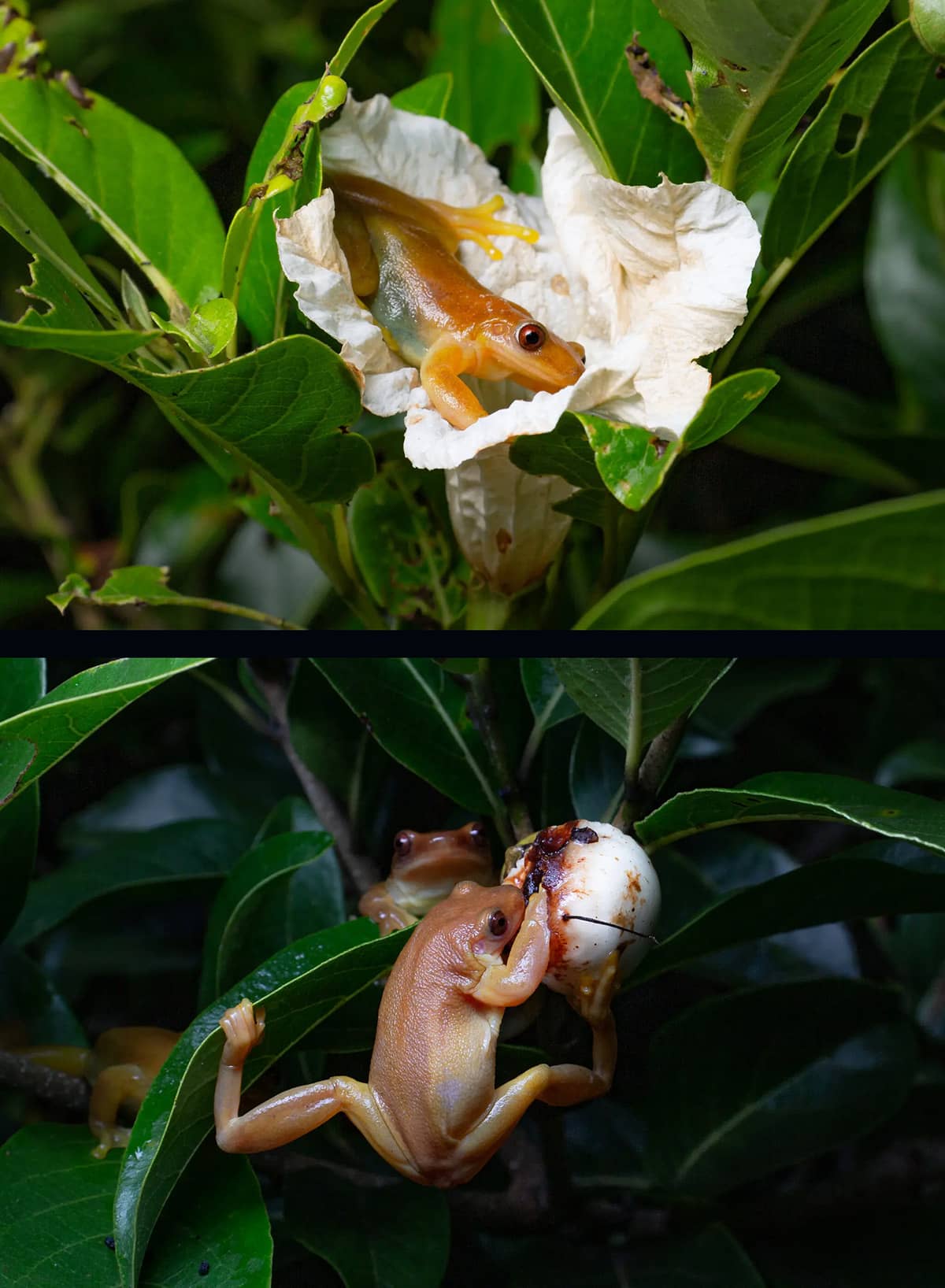Above. Top. Emerging from the Brazilian milk fruit flower with pollen grains on its back. Bottom. Xenohyla truncata Emerging from the Brazilian milk fruit flower with pollen grains on its back. Photo Credit – Carlos Henrique de-Oliveira-Nogueira
On balmy evenings in the vicinity of Rio de Janeiro, a peculiar sight might greet you – milk fruit trees adorned with brownish-orange frogs. Most frog species have an insect-based diet, but the Xenohyla truncata tree frog has developed a taste for the fruity pulp and nectar within the tree’s flowers.
As these resourceful frogs strive to reach the nectar, they submerge their entire bodies into the flowers, with only their rear ends visible. In doing so, pollen accumulates on their heads and backs. Once they emerge from the flowers, they hop away, potentially transferring the pollen to the next milk fruit flower they visit.
In effect, the frogs may inadvertently disperse the plant’s seeds and pollinate its flowers – an unprecedented observation in the world of amphibians.
A peculiar sight might greet you on balmy evenings near Rio de Janeiro – milk fruit trees adorned with brownish-orange frogs. Most frog species have an insect-based diet, but the Xenohyla truncata tree frog has developed a taste for the fruity pulp and nectar within the tree’s flowers.
As these resourceful frogs strive to reach the nectar, they submerge their entire bodies into the flowers, with only their rear ends visible. In doing so, pollen accumulates on their heads and backs. Once they emerge from the flowers, they hop away, potentially transferring the pollen to the next milk fruit flower they visit.
In effect, the frogs may inadvertently disperse the plant’s seeds and pollinate its flowers – an unprecedented observation in the world of amphibians. The study was authored by eight people associated with Professor L. F. Toledo’s lab (Laboratório de História Natural de Anfíbios Brasileiros (LaHNAB), Departamento de Biologia Animal, Instituto de Biologia, Universidade Estadual de Campinas, Campinas, São Paulo 13083-970, Brazil). The paper’s abstract reads as follows.
Pollination and seed dispersal are determinants for plant survivorship. Among land vertebrates, mammals and birds stand out in these relationships with plants. On the other hand, frogs are not expected to play a role in these interactions, as nearly all species are carnivorous (mostly insectivorous) after metamorphosis. However, one species attracts attention: Xenohyla truncata, which includes plant parts on its natural diet. Recently, we observed unexpected interactions between this Neotropical treefrog and plants in their native range. The frog fed on different plant parts, consuming fruits, floral structures and nectar with suction-like movements, and we observed pollen grains adhered to the frog’s back, which renders this treefrog as a potential pollinator, besides its already established role as seed disperser. Nectar ingestion during the reproductive season could benefit individuals under high energetic demand. This is a unique and outstanding example of unforeseen interactions between amphibians and plants.
Hyla truncata was described in 1959 by Izecksohn, from the type locality “próxima à margem direita do rio Guandu, no km 37 da Rodovia Presidente Dutra, no municipio de Itaguaí, Estado do Rio de Janeiro, Brasil”. In 1998 it was moved to Xenohyla by Izeckshn. In 1989 da Silva et al. noted its frugivory and seed dispersal habitats.
Citation
de-Oliveira-Nogueira CH, Souza UF, Machado TM, Figueiredo-de-Andrade CA, Mônico AT, Sazima I, Sazima M, Toledo LF. 2023. Between fruits, flowers and nectar: The extraordinary diet of the frog Xenohyla truncata. Food Webs, 35:e00281.
da Silva et al. 1989. Frugivory and Seed Dispersal by Hyla truncata, a Neotropical Treefrog. Copeia. 1989 (3): 781–783.












